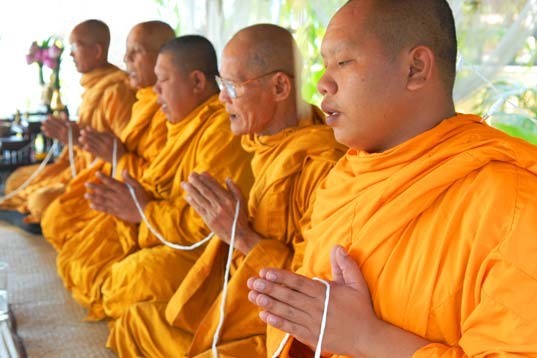World Religion: What Buddhism teaches about sex
Most religions have strict and elaborate rules on sexual conduct. Buddhists have the Third Precept - in Pali, Kamesu micchacara veramani sikkhapadam samadiyami - which is commonly translated as "Do not indulge in sexual misconduct" or "Do not abuse sex". However, for lay people, the early scriptures are confused as to what constitutes "sexual misconduct".
Monastic rules
Most monks and nuns follow the numerous rules of Vinaya Pitaka. For example, monks and nuns who engage in sexual intercourse are "defeated" and are automatically expelled from the order. If a monk makes sexually suggestive comments to a woman, the community of monks must meet and face transgression. A monk should avoid even the appearance of impropriety by being alone with a woman. The nuns may not allow men to touch, rub or stroke them anywhere between the collar and the knees.
Clerics of most Buddhist schools in Asia continue to follow Vinaya Pitaka, with the exception of Japan.
Shinran Shonin (1173-1262), founder of the Japanese pure land school of Jodo Shinshu, got married and also authorized Jodo Shinshu priests to marry. In the centuries following his death, the marriage of Japanese Buddhist monks may not have been the rule, but it was a frequent exception.
In 1872, the Japanese Meiji government decreed that Buddhist monks and priests (but not nuns) would be free to marry if they chose to do so. Soon the "temple families" became common (they had existed before the decree, but people pretended not to notice) and the administration of temples and monasteries often became a family business, handed down from fathers to children. Today in Japan - and in the schools of Buddhism imported into the West from Japan - the question of monastic celibacy is decided differently from sect to sect and from monk to monk.
The challenge for lay Buddhists
Lay Buddhists - those who are not monks or nuns - must also decide for themselves whether the vague precaution against "sexual misconduct" should be interpreted as an approval of celibacy. Most people are inspired by what constitutes "misconduct" from their culture, and we see it in much of Asian Buddhism.
We can all agree, without further discussion, that non-consensual or exploitative sex is "misconduct". In addition, what constitutes "misconduct" within Buddhism is less clear. Philosophy challenges us to think of sexual ethics in a very different way from how most of us have been taught.
Live the precepts
The precepts of Buddhism are not commandments. They are followed as a personal commitment to Buddhist practice. Failing is not skilled (akusala) but it is not a sin - after all, there is no God to sin against.
Furthermore, precepts are principles, not rules, and it is up to individual Buddhists to decide how to apply them. This requires a greater degree of discipline and honesty than the legalistic "just follow the rules and don't ask questions" ethics approach. The Buddha said, "Be a refuge for yourself." It taught us to use our judgment when it comes to religious and moral teachings.
Followers of other religions often claim that without clear and explicit rules, people will behave selfishly and do what they want. This sells humanity short. Buddhism shows us that we can reduce our selfishness, our greed and our attachments, that we can cultivate loving-kindness and compassion, and by doing so we can increase the amount of good in the world.
A person who remains in the grip of self-centered ideas and who has little compassion in his heart is not a moral person, regardless of how many rules he follows. Such a person always finds ways to bend the rules to ignore and exploit others.
Specific sexual problems
Marriage. Most of the religions and moral codes of the West draw a clear and bright line around marriage. Sex inside the line is good, while sex outside the line is bad. Although monogamous marriage is ideal, Buddhism generally takes the attitude that sex between two people who love each other is moral, regardless of whether they are married or not. On the other hand, sex within marriages can be offensive and marriage does not make that abuse moral.
Homosexuality. You can find anti-homosexual teachings in some schools of Buddhism, but most of them reflect local cultural attitudes more than Buddhism itself does. Today in the various schools of Buddhism, only Tibetan Buddhism specifically discourages sex between men (although not among women). The ban comes from the work of a XNUMXth-century scholar named Tsongkhapa, who probably based his ideas on previous Tibetan texts.
Desire. The second noble truth teaches that the cause of suffering is craving or thirst (tanha). This does not mean that cravings should be repressed or denied. Instead, in Buddhist practice, we recognize our passions and learn to see that they are empty, so they no longer control us. This is true of hatred, greed and other negative emotions. Sexual desire is no different.
In "The Mind of Clover: Essays in Zen Buddhist Ethics", Robert Aitken Roshi states that "[f] or all its ecstatic nature, for all its power, sex is just another human drive. If we avoid it just because it is more difficult to integrate than anger or fear, then we are simply saying that when the chips are low we cannot follow our practice. This is dishonest and unhealthy. ”
In Vajrayana Buddhism, the energy of desire is redirected as a way of achieving enlightenment.
The middle way
Western culture at the moment seems to be at war with itself for sex, with rigid Puritanism on one side and licentiousness on the other. Always, Buddhism teaches us to avoid extremes and find a middle ground. As individuals, we can make different decisions, but it is wisdom (prajna) and loving kindness (metta), not lists of rules, that show us the path.
